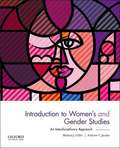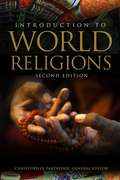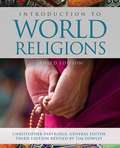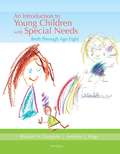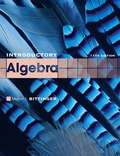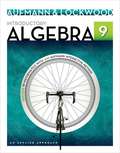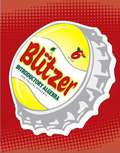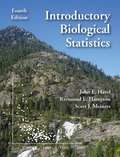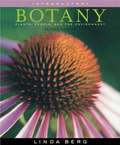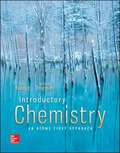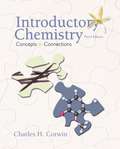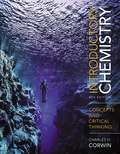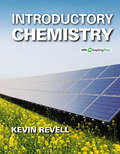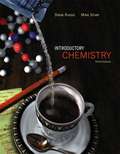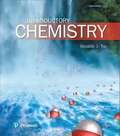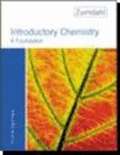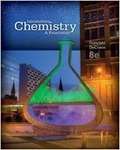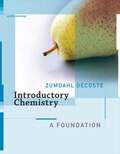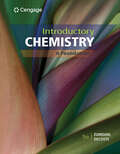- Table View
- List View
Introduction to Women's and Gender Studies: An Interdisciplinary Approach
by Melissa J. Gillis Andrew T. JacobsThis book is a truly interdisciplinary and intersectional text featuring global examples for women's, gender, and sexuality studies. Its student-centered rhetorical approach and pedagogical features―including an engaging image program, prompts for activism, a comprehensive glossary, appendices of key terms, annotated bibliographies for additional reading, and "Feminisms in Brief"―aid students in assimilating fundamental women's and gender studies terms and concepts. <P><P>While it is a textbook and not an anthology, it adopts the best facets of the anthology approach: it includes discussions of frequently anthologized writers and writing that is more engaging and narrative in style than traditional textbooks. The book systematically covers core interdisciplinary concepts so that students are prepared for women's and gender studies courses in a variety of disciplines.
Introduction To World Religions
by Christopher Partridge Tim DowleyA leading textbook for world religion, this new edition is designed to help students in their study and research of the world's religious traditions. Known and valued for its balanced approach and its respected board of consulting editors, this text addresses ways to study religion, provides broad coverage of diverse religions, and offers an arresting layout with rich illustrations. The second edition has new and extended primary source readings, a stronger section on the religions of South Asia, additional maps, a new full-color, student-friendly format, and more.
Introduction To World Religions
by Christopher Partridge Timothy DowleyThis leading textbook for world religion is designed to help students in their study and research of the world's religious traditions. Known and valued for its balanced approach and its respected board of consulting editors, this text addresses ways to study religion, provides broad coverage of diverse religions, and offers an arresting layout with rich illustrations. Introductory sections on understanding religion and the religions of antiquity lay the foundation for the study of the numerous religious traditions highlighted in the volume, including indigenous religions, Hinduism, Buddhism, Jainism, Judaism, Christianity, Islam, Sikhism, and Chinese, Korean, and Japanese religions. <p><p> The user-friendly content is enhanced by charts of religious festivals, historic timelines, updated maps of the world's religions, and a useful glossary. Both historical overviews and modern perspectives for each religion are included. This third edition has several updates, including a new design, a new section on women and religion, and a newly revised section on religions in today's world.
An Introduction to Young Children with Special Needs Birth Through Age Eight
by Jennifer L. Kilgo Richard M. GargiuloAN INTRODUCTION TO YOUNG CHILDREN WITH SPECIAL NEEDS offers a thorough introduction to the educational policies, programs, practices, and services specific to infants, toddlers, and preschoolers who demonstrate delays and disabilities. It also offers information about youngsters who exhibit signs of being at-risk for future programs in learning and development. Through a host of proven learning techniques, a website, and additional related resources, readers are guided to a full understanding of important theoretical and philosophical foundations in serving children whose learning is delayed. These include authentic assessments, cultural sensitivity and competence, activity-based interventions, and developmentally and individually appropriate practices. The book emphasizes instructional strategies necessary for creating inclusive learning environments, and offers recommendations throughout for using technology in the learning environment.
Introductory Algebra 9th Edition
by Margaret L. Lial John Hornsby Terry McginnisStudents who have never studied algebra--as well as those who require further review of basic algebraic concepts before taking additional courses in mathematics, business, science, nursing, or other fields--will benefit from the text's student-oriented approach.
Introductory Algebra An Applied Approach 9th Edition
by Richard N. Aufmann Joanne S. LockwoodAs in previous editions, the focus in INTRODUCTORY ALGEBRA remains on the Aufmann Interactive Method (AIM). Students are encouraged to be active participants in the classroom and in their own studies as they work through the examples. Student engagement is crucial to success.
Introductory Algebra for College Students (Sixth Edition)
by Robert BlitzerThis book provides comprehensive, in-depth coverage of the topics required in a one-term course in beginning or introductory algebra.
Introductory Algebra Student Workbook, Vol. 2 (Fifth Edition)
by Scottsdale Community College Mathematics DepartmentIntroductory Algebra Student Workbook V2 is designed to lead students through Introductory Algebra
Introductory Biological Statistics
by John E. Havel Raymond E. Hampton Scott J. MeinersCourses such as statistics, which develop quantitative analytical skills, remain important preparation for careers in the sciences and graduate school. The book supports teaching a one-semester-long course in statistics with a focus on biological examples and applications. Students need not have any prior exposure to probability and statistics, although college algebra is recommended. The book has added concept checks in all of the chapters, as well as more definition boxes and examples. A number of substantive changes has been made in this new edition. The exercises in each chapter have now been sorted into two groups: practice exercises (with solutions in appendix B) and homework exercises (solutions available only to instructors).
Introductory Botany: Plants, People, and the Environment
by Linda R. BergClear and engaging, Linda Berg's INTRODUCTORY BOTANY: PLANTS, PEOPLE, AND THE ENVIRONMENT helps you develop an appreciation of the diverse organisms we call plants, including their remarkable adaptations to the environment and their evolutionary and ecological relationships. Filled with fascinating feature boxes, intriguing chapter-opening stories, and other applied content, the text contains interesting and topical information that will pique your curiosity and help you succeed in your course. Berg shows you the many ways in which plants are fascinating in their own right, important for the existence of all life on Earth, and useful for humans in all aspects of our lives. INTRODUCTORY BOTANY: PLANTS, PEOPLE, AND THE ENVIRONMENT is beautifully and clearly illustrated and features a dynamic art program that helps you visualize even the most complex concepts.
Introductory Chemistry
by David W. BallDavid W. Ball of Cleveland State University brings his new survey of general chemistry text, Introductory Chemistry, to the market with a fresh theme that will be sure to hold student interest: "Chemistry is Everywhere." Introductory Chemistry is intended for a one-semester introductory or preparatory chemistry course.
Introductory Chemistry: An Atoms First Approach (First Edition)
by Julia Burdge Michelle Driessen" From its very origin, Introductory Chemistry: An Atoms First Approach by Julia Burdge and Michelle Driessen has been developed and written using an atoms first approach specific to introductory chemistry. It is not just a pared down version of a general chem-istry text, but carefully crafted with the introductory-chemistry student in mind. The ordering of topics facilitates the conceptual development of chemistry for the novice, rather than the historical development that has been used traditionally. Its language and style are student friendly and conversational; and the importance and wonder of chemistry in everyday life are emphasized at every opportunity. Continuing in the Burdge tradition, this text employs an outstanding art program, a consistent problem-solving approach, interesting applications woven throughout the chapters, and a wide range of end-of-chapter problems. "
Introductory Chemistry: Concepts and Connections (Third Edition)
by Charles H. CorwinThis comprehensive book gives readers easy access to the basic concepts and their relevant connections of the chemical principles operating in everyday life. Numerous examples and real-world applications provide chemistry enthusiasts with long-term, meaningful understandings. Chapter topics include scientific measurements, matter and energy, models of the atom, chemical reactions, the mole concept, liquids and solids, acids and bases, oxidation and reduction, chemical equilibrium, nuclear and organic chemistry, and biochemistry. For those who understand that knowledge of chemistry constitutes an empowering life skill.
Introductory Chemistry: Concepts And Critical Thinking
by Charles H. CorwinWith a renewed focus on critical thinking, conceptual engagement, and problem solving, this 8th Edition of the popular Introductory Chemistry: Concepts and Critical Thinking has been thoroughly revised to better engage today’s readers, while equipping them with skills they need to succeed beyond introductory chemistry. Unique among introductory chemistry texts, this text and all of its supporting materials are written by sole author Chuck Corwin. His experience and passion guide readers as they build confidence through innovative pedagogy, technology, and features designed to appeal to contemporary readers. By presenting chemistry in a clear and interesting way, readers leave their first chemistry course with a positive impression and the desire to learn more. <p><p> The 8th Edition has been updated and modernized with new, relevant examples, new features, and a revised design. Continuing with Introductory Chemistry: Concepts and Critical Thinking ’s reader-friendly approach, Chuck added features such as A Closer Look to provide insights and offer examples of misconceptions, Helpful Hints to provide coaching where readers struggle most, and new chapter openers tied to elements in the periodic table to show readers the connections all around them.
Introductory Chemistry
by Kevin RevellBuilding a Foundation with an Integrated Learning Experience. At its core, Introductory Chemistry is the result of a unique author vision to develop a robust combination of text and digital resources that motivate and build student confidence while providing a foundation for their success. Kevin Revell knows and understands students today. His thoughtful narrative/video/interactive program works seamlessly to provide the most accessible and engaging set of resources for introductory chemistry available. The same author voice is mirrored in all print and digital content, allowing students flexibility and ensuring a fully supported learning experience--whether using a book or going completely digital! Building a Foundation for Retention and Success. Introductory Chemistry introduces students to chemistry with an exceptionally engaging writing style that not only promotes understanding but uses devices like storytelling and analogies to help students learn at a deeper level and retain concepts. Interactive activities and online tutorials offer students targeted, hands-on practice with the most difficult concepts in the course and provide a foundation for conceptual understanding and problem solving skills. Moving from comprehension to retention, students solidify their understanding of material to the point where they just "know it. " Building a Foundation. . . Your Way! Written and developed as a flexible print and digital resource, Introductory Chemistry is designed to serve as a teaching and learning tool to meet instructors and students where they are today and provide support and tools tailored to various learning and teaching styles. Introductory Chemistry comes with a full suite of traditional textbook and lecture resources to support a traditional lecture-based course, as well as resources that make the transition to a more active classroom easier for instructors interested in doing so. Instructors who already subscribe to active learning techniques will also find tools to complement their efforts. Students can choose to access the content in the learning environment that best fits their needs: the printed narrative and pedagogy, the eBook and interactive digital tools, the video lecture modules, or a combination.
Introductory Chemistry
by Steve Russo Michael E. SilverIntroductory Chemistry,Third Edition helps readers master the quantitative skills and conceptual understanding they need to gain a deep understanding of chemistry. Unlike other books on the market that emphasize rote memory of problem-solving algorithms, Introductory Chemistry takes a conceptual approach with the idea that focusing on the concepts behind chemical equations helps readers become more proficient problem solvers. What Is Chemistry?, The Numerical Side of Chemistry, The Evolution of Atomic Theory, The Modern Model of the Atom 1, Chemical Bonding and Nomenclature, The Shape of Molecules, Chemical Reactions, Stoichiometry and the Mole, The Transfer of Electrons from One Atom to Another in a Chemical Reaction Intermolecular Forces and the Phases of Matter, What If There Were No Intermolecular Forces?, The Ideal Gas Solutions, When Reactants Turn into Products, Chemical Equilibrium, Electrolytes, Acids, and Bases, Nuclear Chemistry, The Chemistry of Carbon, Synthetic and Biological Polymers. For all readers interested in introductory chemistry.
Introductory Chemistry
by Nivaldo J. TroBuilds 21st century and problem solving skills, preparing students for success Now in its 6th Edition, the best-selling Introductory Chemistry continues to encourage student interest by showing how chemistry manifests in students’ daily lives. Author Nivaldo Tro draws upon his classroom experience as an award-winning instructor to extend chemistry from the laboratory to the student’s world, capturing student attention with relevant applications and an engaging writing style. The text provides a superior teaching and learning experience, enabling deep conceptual understanding, fostering the development of problem-solving skills, and encouraging interest in chemistry with concrete examples. Extending chemistry from the lab to the student’s world, the text reveals that anyone can master chemistry. Refined to meet its purpose of teaching relevant skills, the 6th Edition includes new questions, data, and sections to help students build the 21st century skills necessary to succeed in introductory chemistry and beyond. Already a visual text, in this edition the art has been further refined and improved, making the visual impact sharper and more targeted to student learning. The new edition also includes new Conceptual Checkpoints, a widely embraced feature that emphasizes understanding rather than calculation, as well as a new category of end-of-chapter questions called Data Interpretation and Analysis, which present real data in real life situations and ask students to analyze and interpret that data.
Introductory Chemistry: A Foundation (5th Edition)
by Steven S. ZumdahlIntroductory Chemistry presents concepts clearly using language and analogies that students can relate to and in a way that supports active learning. The In-Class Discussion Questions provide excellent material for collaborative work. The book connects chemistry to real-life experience at every opportunity, from chapter opening discussions of chemical applications to "Chemistry in Focus" features throughout the book to foster enthusiasm and real understanding as the student uses this text.
Introductory Chemistry: A Foundation (Eighth Edition)
by Steven S. Zumdahl Donald J. DecosteImprove the problem-solving and critical thinking skills you need for success in your introductory chemistry course and beyond with 'Introductory Chemistry'. In-text examples help you learn what questions you should be asking yourself when solving problems and 'Chemistry in Focus' boxes describe the applications of chemistry.
Introductory Chemistry: A Foundation
by Steven S. Zumdahl Donald J. DecosteChemical reactions are covered early, to capture student interest, leaving more abstract material for later chapters. The authors explain chemical concepts by starting with the basics, using symbols or diagrams, and concluding by encouraging students to test their own comprehension of the solution. This step-by-step approach helps students develop critical problem-solving skills. Also, the accessible explanations and visualizations throughout the text motivate students and engage them in the material by helping them to connect abstract chemical principles to real-life experiences. The pedagogy includes chapter-opening discussions that introduce students to relevant applications andChemistry in Focusboxes that describe everyday applications of chemistry such as artificial sweeteners, foaming chewing gum, and fake fats. Current applications appear throughout the text with easy-to-understand explanations and analogies. New! Co-author Donald DeCoste brings experience as an author and as an instructor at University of Illinois, Urbana-Champaign to this new edition. New! HM Assess within Eduspace, Houghton Mifflin's Online Learning Tool, provides a diagnostic assessment tool to test students' understanding of core concepts and track student progress. New! A Multimedia eBook within Eduspace offers a one-stop resource for students to link from textbook content to study resources, including video lessons from Thinkwell, tutorials, flashcards, and ACE quizzes. New!Chapter 10, Energy, combines all the content on energy from Chapter 3 in the Fifth Edition with material on enthalpy, Hess's Law, the difference between the quality and quantity of energy, energy resources in the world, and entropy. Exercises and models such as worked-out examples, self-check exercises, and skill development boxes support the step-by-step problem-solving method. End-of-chapter material covers key terms, a summary of important facts, questions and problems arranged in matched pairs and keyed to chapter sections, additional problems that incorporate material from multiple sections, in-class discussion questions, and "Cumulative Reviews" that tests concepts from preceding chapters. The text builds and refreshes fundamental math skills such as scientific notation, rounding, and rearranging equations. In addition, Math Tips indicated by icons throughout, help students as they perform calculations. Math Review Tutorials on the Online Study Center provide practice for critical math skills. Basic Chemistry,6/e, in paperback, includes chapters 1-16 and provides basic coverage of chemical concepts and applications through acids and bases Introductory Chemistry,6/e, available in hardcover or paperback, includes chapters 1-18 and expands coverage with the addition of equilibrium, oxidation-reduction reactions, electrochemistry, radioactivity, and nuclear energy.
Introductory Chemistry: A Foundation
by Steven S. Zumdahl Donald J. DeCosteThe Eighth Edition of Zumdahl and DeCoste's best-selling INTRODUCTORY CHEMISTRY: A FOUNDATION combines enhanced problem-solving structure with substantial pedagogy to enable students to become strong independent problem solvers in the introductory course and beyond. Capturing student interest through early coverage of chemical reactions, accessible explanations and visualizations, and an emphasis on everyday applications, the authors explain chemical concepts by starting with the basics, using symbols or diagrams, and conclude by encouraging students to test their own understanding of the solution. This step-by-step approach has already helped numerous students master chemical concepts and develop problem-solving skills. The focus on conceptual learning and motivating students by connecting chemical principles to real-life experiences in chapter-opening discussions and "Chemistry in Focus" boxes require students to think through the Example step-by-step rather than simply scan the written Example in the text as many students do.
Introductory Chemistry: A Foundation, AP® Edition
by Steven S. Zumdahl Donald J. DeCosteA bestseller among introductory texts, Zumdahl's "Introductory Chemistry series is a complete teaching system that places a unique emphasis on developing problem-solving skills with a thoughtful step-by-step approach applicable to chemistry and other disciplines. Another important goal of the series is to connect chemistry to real-life experiences, with engaging applications and colorful graphics."Basic Chemistry, 4/e, (Chapters 1-15) provides basic coverage of chemical concepts and applications through acids and bases. Inclusion of acids and bases is new."Introductory Chemistry, 4/e, (Chapters 1-18) expands coverage with the addition of equilibrium, oxidation-reduction reactions, electrochemistry, radioactivity, and nuclear energy. "Introductory Chemistry: A Foundation, 4/e (Chapters, 1-20) includes two chapters which provide a brief introduction to organic and biological chemistry.
Introductory Chemistry: A Foundation
by Steven S. Zumdahl Donald J. DeCosteSucceed in your course with INTRODUCTORY CHEMISTRY: A FOUNDATION! This best-selling text combines enhanced problem-solving structure with substantial pedagogy to help you become a successful problem solver. Early coverage of chemical reactions, accessible explanations and visualizations, and an emphasis on everyday applications facilitates understanding. The authors' step-by-step approach has already helped hundreds of thousands of student's master chemical concepts and develop strong problem-solving skills. Interactive study aids in OWLv2, such as ChemWork Problems and Adaptive Learning Activities, help students master concepts.
Introductory Chemistry: A Foundation
by Steven S. Zumdahl Donald J. DeCosteThe Sixth Edition of Introductory Chemistry: A Foundation offers unparalleled teaching and learning resources, with a robust technology package, in addition to the superior problem-solving pedagogy, engaging writing style, and strong emphasis on everyday applications that comprise the hallmarks of this best-selling text. Chemical reactions are covered early, to capture student interest, leaving more abstract material for later chapters. The authors explain chemical concepts by starting with the basics, using symbols or diagrams, and concluding by encouraging students to test their own comprehension of the solution. <p><p>This step-by-step approach helps students develop critical problem-solving skills. Also, the accessible explanations and visualizations throughout the text motivate students and engage them in the material by helping them to connect abstract chemical principles to real-life experiences. The pedagogy includes chapter-opening discussions that introduce students to relevant applications and Chemistry in Focus boxes that describe everyday applications of chemistry such as artificial sweeteners, foaming chewing gum, and fake fats. Current applications appear throughout the text with easy-to-understand explanations and analogies.
